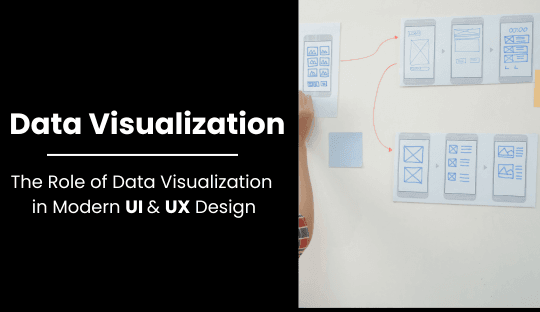
The Role of Data Visualization in Modern UI/UX Design
In the age of big data, the ability to interpret and present complex information in an accessible and engaging manner has become crucial. Data visualization, a powerful tool in UI/UX design, transforms raw data into visual elements like charts, graphs, and maps, making it easier to understand and use. At FlyKez CO, a leading UI design agency in Belgium, we emphasize the importance of data visualization in creating intuitive and effective digital experiences. This blog explores the role of data visualization in modern UI/UX design, highlighting its benefits, techniques, and best practices.
The Importance of Data Visualization
Data visualization enhances the user experience by providing clear, concise, and actionable insights. It bridges the gap between data and understanding, enabling users to quickly grasp trends, patterns, and outliers without wading through endless numbers and spreadsheets. For businesses, this means making informed decisions faster and more accurately.
Benefits of Data Visualization in UI/UX Design
1. Improved Comprehension
Visual representations of data make complex information more digestible. Users can quickly interpret visual data, leading to better understanding and quicker decision-making. This is particularly beneficial for dashboards and analytics platforms where users need to process large volumes of information efficiently.
2. Enhanced Engagement
Interactive data visualizations engage users more effectively than static data. By allowing users to manipulate and explore data, such as through filtering and zooming, interactive visualizations create a more engaging and immersive experience. This increased interactivity can lead to greater user satisfaction and retention.
3. Better Decision-Making
Data visualizations provide clear insights that can inform strategic decisions. By highlighting key data points and trends, visualizations help users identify opportunities and risks, making it easier to make data-driven decisions. For example, in e-commerce, visualizing sales trends can help businesses optimize their inventory and marketing strategies.
Techniques for Effective Data Visualization
1. Choose the Right Type of Visualization
Different types of data require different visualization techniques. Bar charts, pie charts, line graphs, and scatter plots each have their strengths and are suited to specific kinds of data. Selecting the appropriate visualization type is crucial for accurately conveying the intended message.
2. Keep It Simple
Simplicity is key in data visualization. Overcomplicating visuals with too many elements can confuse users and obscure the data’s message. Focus on clarity and avoid unnecessary embellishments that do not add value to the data presentation.
3. Use Color Effectively
Color can enhance data visualization by highlighting important information and distinguishing between different data sets. However, it’s essential to use color judiciously to avoid overwhelming the user. Ensure that color choices are consistent and that the visualizations are accessible to colorblind users. Also Read About Top Mistakes to Avoid in Custom Packaging Design
4. Incorporate Interactivity
Interactive elements, such as tooltips, filters, and zoom functionalities, can greatly enhance the user experience. Interactivity allows users to explore the data in depth and discover insights on their own, leading to a more personalized and engaging experience.
Examples of Data Visualization in UI/UX Design
1. Business Dashboards
Business dashboards are a prime example of effective data visualization in UI/UX design. They consolidate various metrics and KPIs into a single view, allowing users to monitor performance at a glance. Interactive elements enable users to drill down into specific data points for more detailed analysis.
2. E-commerce Analytics
E-commerce platforms use data visualization to present sales data, customer behavior, and inventory levels. Visualizing this data helps businesses identify trends, optimize stock levels, and tailor marketing efforts to improve sales and customer satisfaction.
3. Healthcare Applications
In healthcare, data visualization plays a critical role in presenting patient data, treatment outcomes, and resource utilization. Visual tools help healthcare professionals quickly interpret complex medical data, leading to better patient care and more efficient resource management.
4. Financial Services
Financial services leverage data visualization to present market trends, portfolio performance, and risk assessments. These visualizations help investors and financial analysts make informed decisions by providing clear and comprehensive insights into financial data.
Best Practices for Data Visualization in UI/UX Design
1. Understand Your Audience
Tailor your data visualizations to the needs and preferences of your target audience. Consider their level of data literacy and the context in which they will be using the visualizations. This ensures that the visualizations are relevant, accessible, and easy to understand.
2. Focus on Key Metrics
Highlight the most important data points and metrics to avoid overwhelming users with too much information. Use visual hierarchy to guide users’ attention to the most critical insights.
3. Test and Iterate
Continuous testing and iteration are crucial for effective data visualization. Gather user feedback to identify areas for improvement and refine the visualizations based on real user interactions. This iterative process ensures that the visualizations meet user needs and deliver maximum value.
Conclusion
Data visualization is a powerful tool in modern UI/UX design, transforming complex data into actionable insights. As a leading brand design agency in Belgium, FlyKez CO is committed to leveraging the latest data visualization techniques to create intuitive and engaging digital experiences. By focusing on clarity, simplicity, and interactivity, we help businesses make data-driven decisions and enhance user satisfaction.
For more information on how FlyKez CO can help your business leverage data visualization in UI/UX design, visit our website at FlyKez CO.
